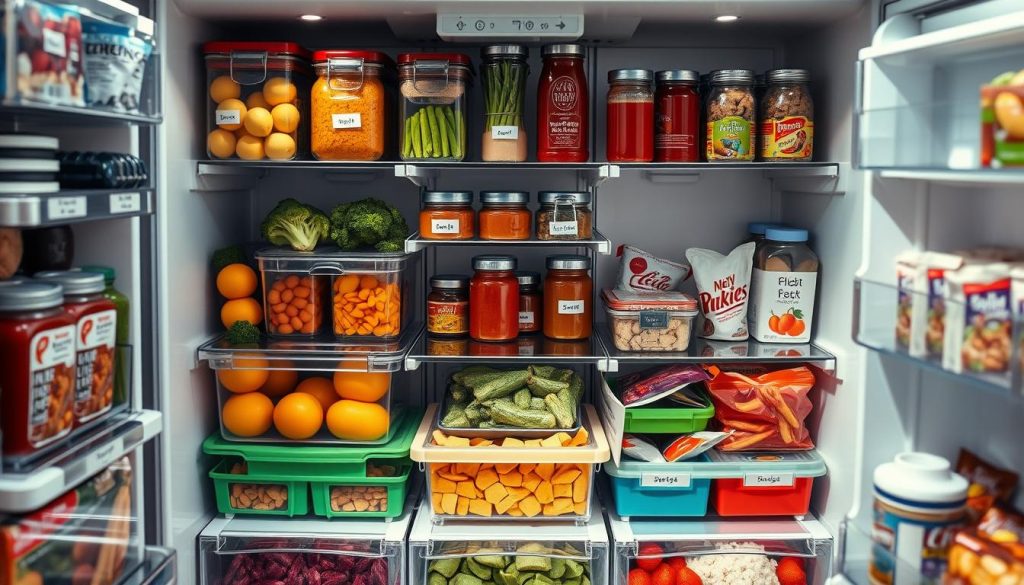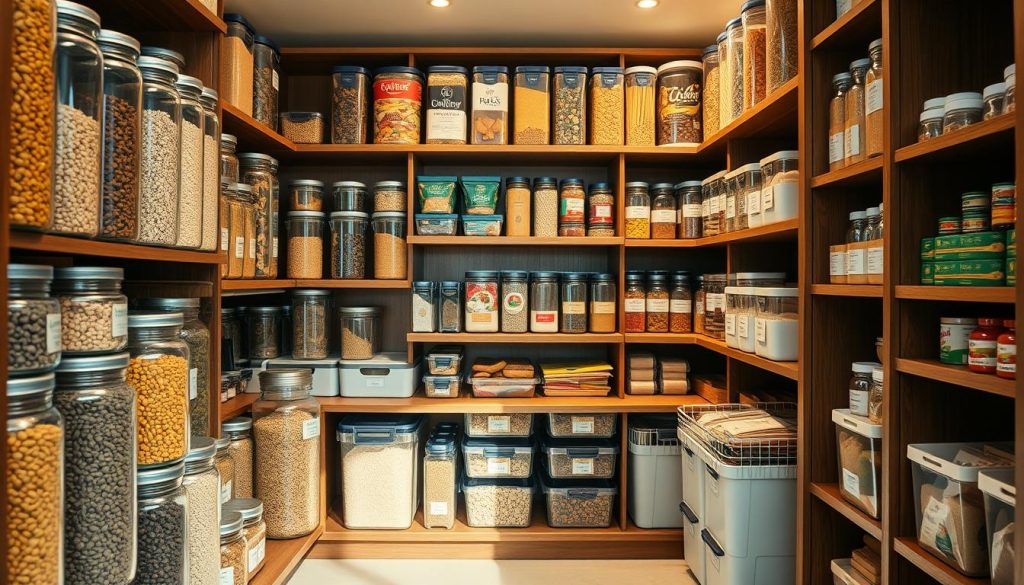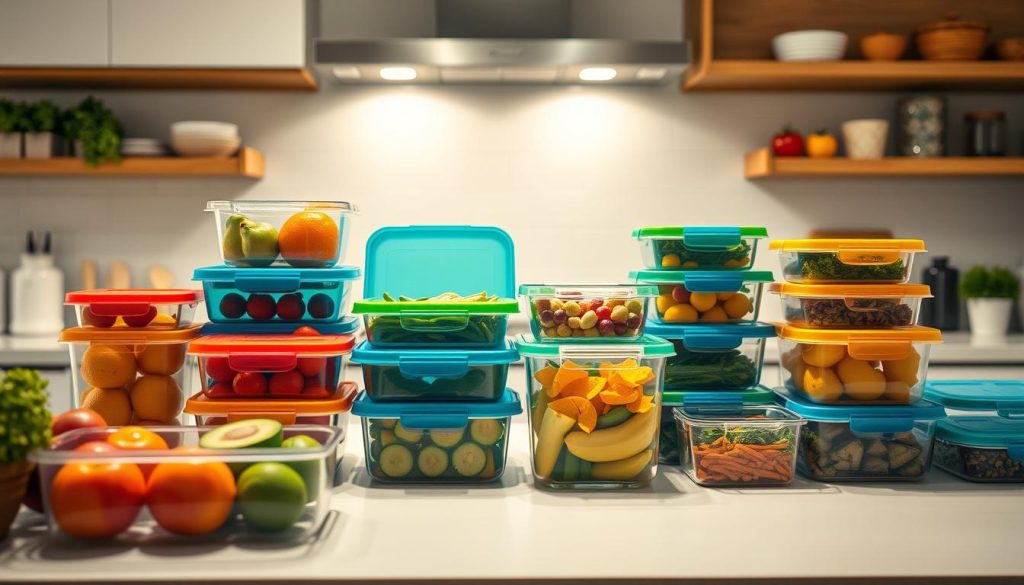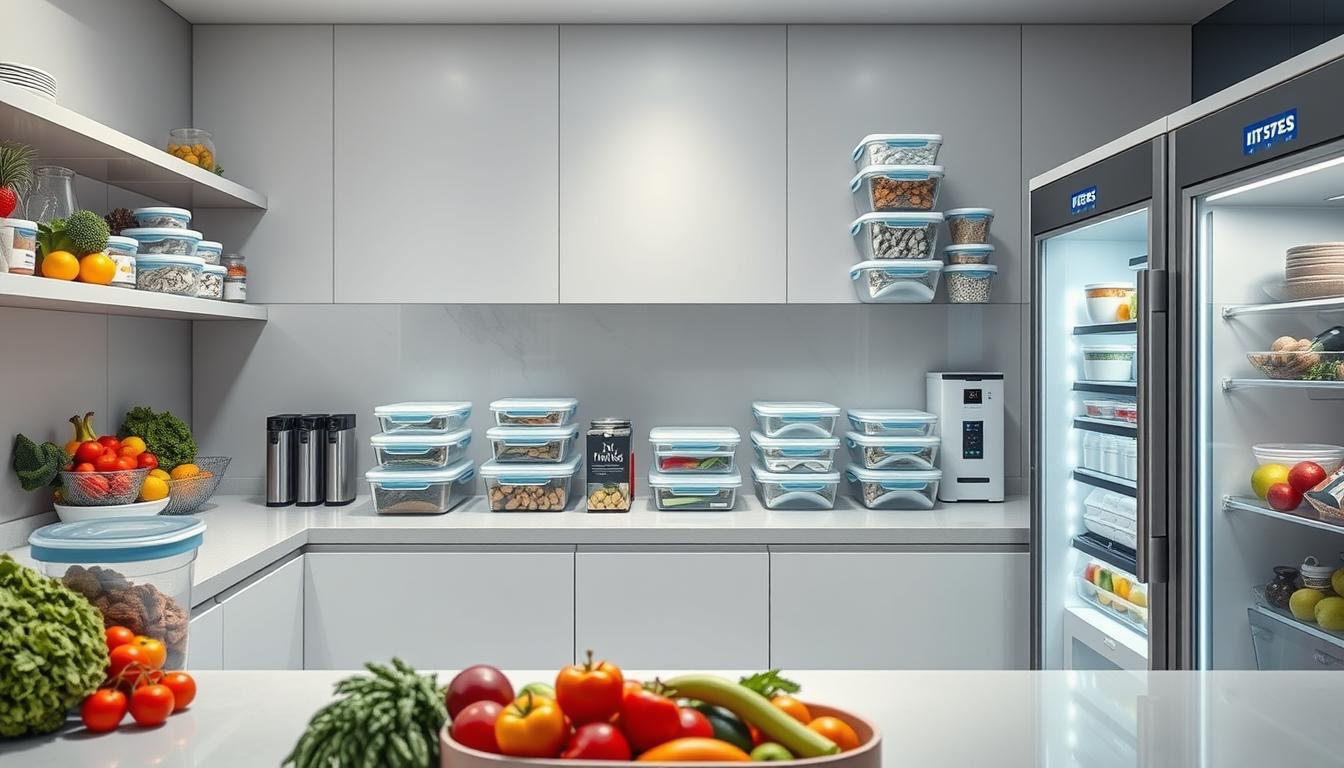I love a well-organized kitchen. It’s the heart of my home, where I create delicious meals and lasting memories. But keeping it tidy can be a challenge. That’s why I’m excited to share some smart food storage solutions that have transformed my kitchen space.
Proper food storage is key to kitchen organization and waste reduction. By using the right techniques, I’ve extended the life of my groceries, saved money, and made my kitchen more efficient. These simple changes have made a big difference in how I cook and live.
In this guide, I’ll walk you through practical tips for storing food smartly. From airtight containers to fridge organization, you’ll find ideas to fit any kitchen size. Let’s dive in and discover how to keep your food fresh and your kitchen clutter-free.
The Importance of Effective Food Storage
Effective food storage is crucial for any kitchen. It’s not just about keeping things tidy. It’s a game-changer for food preservation, kitchen space optimization, and food safety. Let me break it down for you.
First off, proper storage techniques are key to maintaining food quality. When I store my groceries correctly, they stay fresh longer. This saves me money and reduces waste. It’s amazing how much longer produce lasts when it’s stored right!
Food safety is another big reason to focus on storage. By keeping foods at the right temperature and in appropriate containers, I dramatically reduce the risk of foodborne illnesses. It’s peace of mind I can’t put a price on.
Let’s talk kitchen space optimization. Smart storage solutions help me make the most of every inch in my kitchen. I use stackable containers, door organizers, and lazy Susans to maximize space and keep everything accessible.
| Storage Method | Benefits | Best For |
|---|---|---|
| Airtight Containers | Prevents moisture, extends shelf life | Dry goods, baked items |
| Vacuum Sealing | Removes air, prevents freezer burn | Meats, bulk items |
| Glass Jars | Non-reactive, easy to clean | Sauces, pickles, jams |
Effective food storage isn’t just a habit – it’s a lifestyle change. It’s improved my cooking experience and kitchen efficiency. Trust me, once you get it right, you’ll wonder how you ever managed without it!
Airtight Containers: Your First Line of Defense
Airtight containers are key for any organized kitchen. They help keep food fresh and reduce waste. Let’s look at how to use them for better pantry management.
Choosing the Right Airtight Containers
When picking containers, think about size, shape, and material. Square or rectangular ones save space. Clear ones make it easy to see what’s inside. Here’s a quick guide:
| Container Type | Best For | Features |
|---|---|---|
| Glass | Dry goods, leftovers | Durable, non-reactive, microwave-safe |
| Plastic | Snacks, lightweight items | Lightweight, shatterproof |
| Stainless Steel | Bulk storage, outdoor use | Rust-resistant, opaque |
Best Materials for Long-Term Storage
For long-term storage, I choose glass or high-quality plastic. Glass doesn’t absorb odors or stains. BPA-free plastic is light and less likely to break. Both keep food fresh for months when sealed right.
Labeling and Organizing Your Airtight Containers
Good labeling is key for pantry management. I use waterproof labels for contents and dates. I organize by grouping similar items and keeping often-used ones easy to reach. This helps me keep track and cut down on waste.
Using these strategies, my pantry is now efficient and organized. Airtight containers are essential in my kitchen. They help keep my ingredients fresh and meals ready to go.
Mastering Refrigerator Organization

Effective refrigerator organization is crucial for a tidy kitchen. Smart food storage solutions help keep your fridge organized and food fresh.
Begin by grouping similar items together. Store dairy products on one shelf, meats on another, and fruits and vegetables in separate drawers. This makes finding items easier and prevents contamination.
Use clear containers for leftovers and prepped ingredients. They let you see what’s inside, helping reduce waste. Label these containers with dates to keep track of freshness.
To make the most of vertical space, use stackable containers or add extra shelves. This simple step can greatly increase your storage.
| Zone | Temperature | Ideal for |
|---|---|---|
| Upper Shelves | 35-38°F | Drinks, leftovers, ready-to-eat foods |
| Lower Shelves | 32-35°F | Raw meats, fish, poultry |
| Crisper Drawers | 32-40°F | Fruits and vegetables |
| Door | 38-40°F | Condiments, butter, soft cheeses |
The door is the warmest part of your fridge. Use it for items that don’t spoil quickly. By organizing your fridge, you’ll make your kitchen more efficient and keep your groceries fresh longer.
Pantry Management: From Chaos to Order

A well-organized pantry is essential for efficient kitchen organization. It turns a chaotic space into a functional food storage hub. I’ve found that tackling pantry management can transform a chaotic space into a functional food storage hub.
Categorizing Your Pantry Items
To start, I group similar items together. This makes finding ingredients easier and prevents overbuying. My categories include:
- Baking supplies
- Canned goods
- Grains and pasta
- Snacks
- Condiments
Space-Saving Pantry Solutions
Maximizing space is crucial for effective pantry management. I use clear, stackable containers and lazy Susans to utilize every inch. Door-mounted racks are perfect for spices and small items.
Maintaining a Well-Stocked Pantry
Keeping my pantry stocked requires regular inventory checks. I maintain a list of essentials and replenish them before they run out. This ensures I always have ingredients on hand for quick meals.
| Pantry Item | Storage Method | Shelf Life |
|---|---|---|
| Flour | Airtight container | 6-8 months |
| Canned vegetables | Original packaging | 2-5 years |
| Rice | Sealed container | Up to 2 years |
| Pasta | Airtight container | 1-2 years |
By implementing these pantry management strategies, I’ve created an organized system. It streamlines meal prep and reduces food waste. These food storage solutions have truly transformed my kitchen organization.
Meal Prep Containers: A Game-Changer for Busy Kitchens

Meal prep containers have changed the game for busy kitchens. They make organizing and planning meals easier. With a good set, my weekly routine is smoother, and I waste less food.
There are many sizes and materials of meal prep containers. I use glass for reheating and BPA-free plastic for lunches on the go. They stack well in my fridge, saving space and keeping things tidy.
Here’s how meal prep containers have improved my kitchen:
- Portion control: Pre-portioned meals help me stick to my diet goals
- Time-saving: I cook once and have meals ready for the entire week
- Reduced food waste: Leftovers are easily stored and consumed later
- Organized fridge: Clear containers make it easy to see what’s inside
Adding meal prep containers to my kitchen has been a game-changer. It’s incredible how a simple solution can make such a big impact on managing a busy home.
Innovative Produce Preservation Techniques
I’ve found some amazing ways to keep fruits and veggies fresh. These methods help them last longer and cut down on food waste.
Ethylene-Sensitive Produce Storage
Ethylene gas makes some fruits ripen faster. I keep ethylene-producing fruits like apples and bananas away from ethylene-sensitive ones like leafy greens. This trick helps keep everything fresh for longer.
Herb Preservation Methods
Fresh herbs add great flavor but spoil fast. Freezing them in olive oil ice cubes keeps their taste and nutrients. For dried herbs, I store them in airtight containers, away from heat and light.
Fruit and Vegetable Storage Hacks
I wrap celery in aluminum foil to keep it fresh for weeks. For berries, a vinegar rinse before storage stops mold. These small tips make a big difference in keeping produce fresh.
| Produce | Storage Method | Shelf Life |
|---|---|---|
| Lettuce | Paper towel-lined container | 1-2 weeks |
| Carrots | Water-filled container | 2-3 weeks |
| Tomatoes | Room temperature, stem-side up | 5-7 days |
Using these smart storage tips, I’ve cut down food waste a lot. These methods save money and make sure I always have fresh produce for tasty, healthy meals.
Clever Leftovers Storage Strategies
Smart leftovers storage is key to reducing food waste and saving money. By mastering a few simple techniques, you can turn yesterday’s meals into today’s delicious dishes.
First, invest in quality food storage containers. Glass or BPA-free plastic containers with airtight lids are perfect for keeping leftovers fresh. I always portion out leftovers into individual servings, making it easy to grab a quick lunch or dinner.
Labeling is crucial for effective leftovers management. I use a dry-erase marker to write the contents and date on each container. This simple step helps me track freshness and use items before they spoil.
Get creative with your leftovers! Transform them into new meals. Leftover roast chicken can become a tasty chicken salad, while extra vegetables are perfect for a quick stir-fry or soup.
| Leftover Item | Storage Method | Repurposing Idea |
|---|---|---|
| Cooked Rice | Airtight container in fridge | Fried rice or rice pudding |
| Roasted Vegetables | Glass container with lid | Veggie frittata or wrap filling |
| Grilled Chicken | Wrapped in foil, then bagged | Chicken tacos or salad topping |
Remember, proper food storage solutions not only extend the life of your leftovers but also contribute to food waste reduction. By implementing these strategies, you’ll save time, money, and reduce your environmental impact.
Food Storage Solutions for Every Kitchen Size
I’ve seen kitchens of all shapes and sizes. Smart food storage solutions are key to any well-organized space. Whether you’re working with a tiny apartment or a spacious home, there are ways to maximize your kitchen’s potential.
For small kitchens, vertical storage is your best friend. I love using over-the-door organizers for pantry management. They’re perfect for storing spices, snacks, and small containers. Wall-mounted magnetic strips are great for knives and metal utensils, freeing up valuable drawer space.
In larger kitchens, I focus on zoning. Create dedicated areas for baking, meal prep, and snacks. Use pull-out drawers in deep cabinets to make items at the back easily accessible. For pantry management, invest in clear, stackable containers to keep dry goods fresh and visible.
- Use drawer dividers for utensils and small tools
- Install a pegboard for hanging pots and pans
- Utilize corner spaces with lazy Susans
Remember, effective kitchen space optimization isn’t just about cramming everything in. It’s about creating a functional system that works for your cooking style. With the right food storage solutions, even the smallest kitchen can be a joy to cook in.
Reducing Food Waste Through Smart Storage
Smart food storage is crucial for cutting down waste in my kitchen. Using the right solutions keeps my ingredients fresh and saves money. Small changes in kitchen organization can greatly reduce food waste.
Storing fruits and veggies properly is a favorite tip of mine. I keep apples away from other foods to slow down spoilage. For leafy greens, I wrap them in a damp paper towel before storing. These steps help my produce last longer.
Portion control is another effective way to reduce waste. I use meal prep containers for leftovers, making single servings easy to grab. This way, nothing gets forgotten in the fridge. Seeing my food organized motivates me to use it all.
These strategies have made a big difference in my kitchen. I throw out less and save on groceries. It’s a win-win that makes me feel good about helping the environment.
